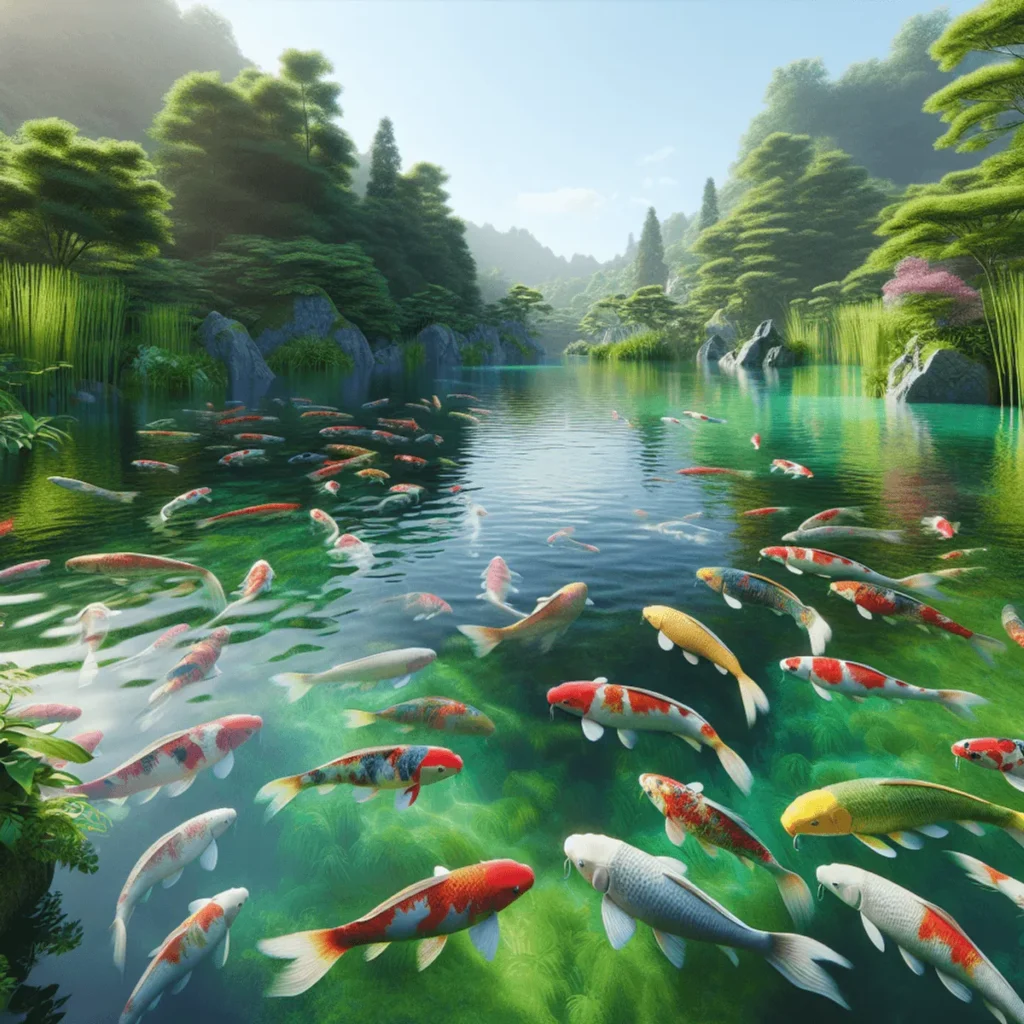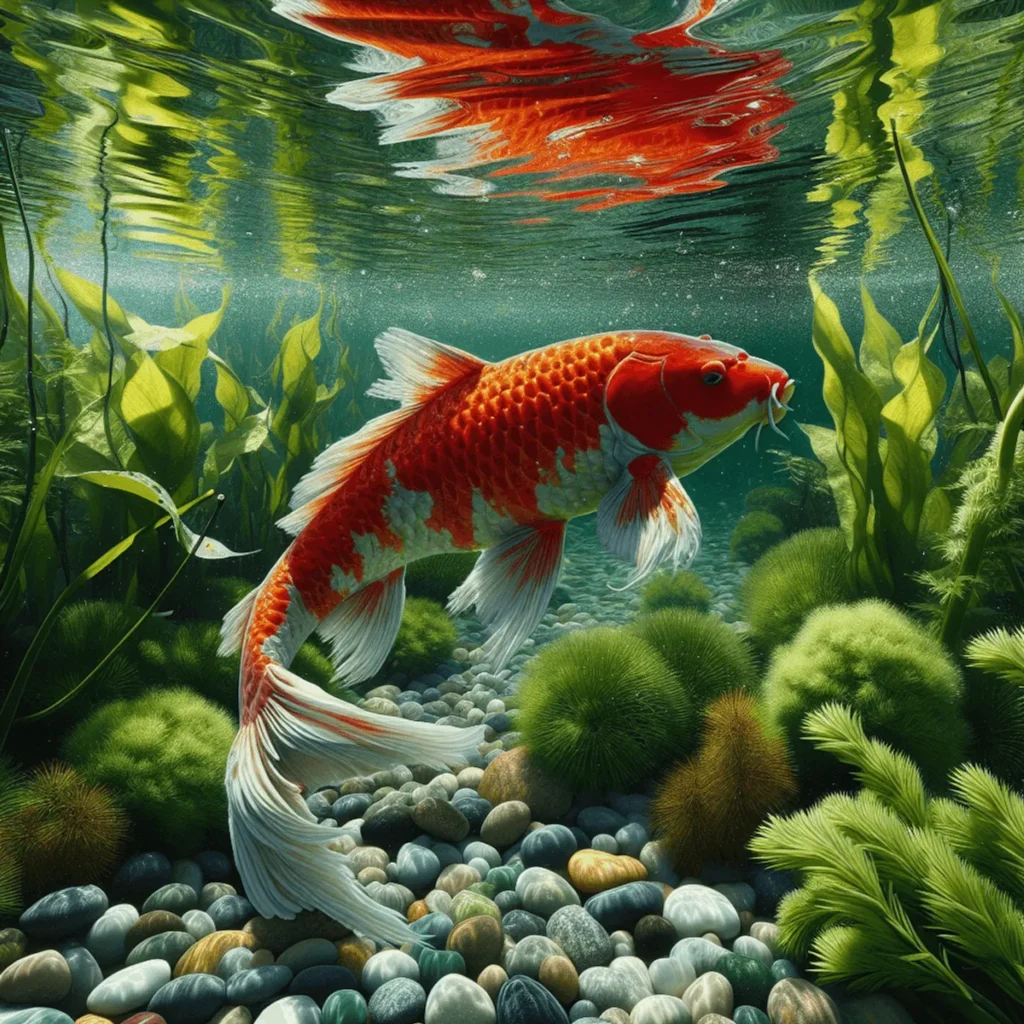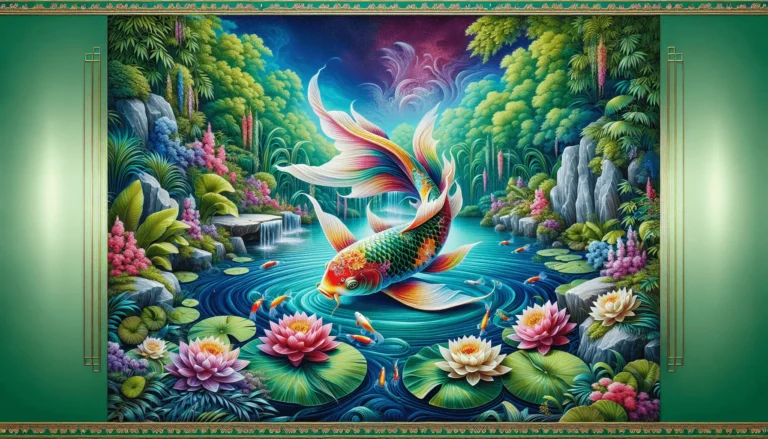Koi fish, known for their bright colors and graceful swimming, have become very popular as ornamental pets. These freshwater fish, originally bred in Japan during the 19th century, are a variety of the Amur carp species. Over time, they have fascinated enthusiasts worldwide, often becoming the main attraction of outdoor ponds and garden water features.
Key takeaway: Koi fish are freshwater fish. Understanding their habitat and care requirements is crucial for their health and longevity. These beautiful creatures thrive in well-maintained pond environments that mimic their natural freshwater habitats.
This article aims to provide a clear guide on whether koi fish are saltwater or freshwater. We will focus on their natural habitat and care in ponds to help you create the best environment for your koi fish.
Koi Fish: Freshwater Beauties
Koi fish, scientifically known as Cyprinus rubrofuscus, are a domesticated variety of the Amur carp species. Originating in Japan during the 19th century, these ornamental creatures, commonly referred to as Nishikigoi, have been selectively bred for their vibrant colors and distinctive patterns.
In Japanese culture, koi fish hold significant historical and symbolic value. They are often seen as symbols of strength, perseverance, and good fortune. Many Japanese gardens feature koi ponds as focal points, celebrating the beauty and serenity these fish bring to their surroundings.
Unique Varieties of Koi
There are numerous varieties of koi, each with unique traits:
- Kohaku: White-bodied koi with red markings.
- Sanke: Similar to Kohaku but with additional black markings.
- Showa: Black-bodied fish with red and white patterns.
- Asagi: Blue-gray scales with red accents on the belly and fins.
Each variety offers a different aesthetic appeal, making koi an exciting choice for enthusiasts who appreciate their diversity and elegance.
Understanding Koi Habitats: Ponds vs. Saltwater Environments

Koi fish are exclusively freshwater species. They belong to a variety of the Amur carp and thrive in freshwater habitats such as ponds, lakes, and slow-moving rivers. These environments offer the necessary conditions for their survival and well-being.
read Also: Are Koi Fish Smart? Discover Their Hidden Intelligence
Freshwater Habitats
1. Ponds
Koi fish are typically kept in outdoor ponds, which mimic their natural habitat. These ponds provide ample space for swimming and access to plants and insects that form part of their diet.
2. Lakes and Rivers
In the wild, koi are found in freshwater bodies around the Black, Caspian, and Aral Seas. These environments have stable water temperatures and low salinity levels, crucial for koi health.
Saltwater Environments
Saltwater environments are unsuitable for koi due to several key factors:
- Salinity Levels: Koi fish cannot tolerate high salinity levels found in saltwater environments. Their physiological makeup is adapted to freshwater, making them susceptible to dehydration and stress in saltwater.
- Osmoregulation: Unlike saltwater species that have specialized systems to excrete excess salt, koi lack these adaptations. This makes it difficult for them to maintain proper fluid balance in saline conditions.
Koi thrive best in well-maintained freshwater ponds with adequate filtration and aeration systems. Understanding these habitat requirements ensures their longevity and vibrant health in your pond environment.
For more detailed insights into the optimal conditions for maintaining koi in a pond setting, you can refer to this research on pond management. Additionally, studies on the physiological responses of fish to varying salinity levels further highlight why saltwater environments are detrimental to koi health.
The Role of Salt in Koi Pond Management
Salt is an essential tool in koi pond management, playing a significant role in maintaining the health of your koi fish. When used correctly, non-iodized salt (sodium chloride) can offer numerous benefits for koi health.
Benefits of Using Salt for Koi Health
1. Managing Parasites and Bacteria
Koi fish are susceptible to various parasites and bacteria. These pathogens can cause infections and diseases, significantly impacting the well-being of your fish. Non-iodized salt helps manage these issues by creating an environment that is inhospitable to many parasites and bacteria. When added to the pond at low concentrations, salt can effectively reduce the prevalence of these harmful organisms.
2. Promoting Osmotic Pressure Balance
One of the critical functions of salt in a koi pond is its role in regulating osmotic pressure. Osmotic pressure ensures that water balance within the fish’s body remains stable, which is crucial for their cellular functions. By adding appropriate amounts of sodium chloride to the pond water, you help maintain this balance, preventing conditions like osmotic stress that can weaken the fish’s immune system.
3. Enhancing Overall Health and Resilience
Low concentrations of salt can promote overall health and resilience in koi fish. Salt aids in:
- Improving gill function
- Enhancing mucus production
- Reducing stress levels
These benefits contribute to stronger immune responses and better resistance against diseases. For instance, when koi are stressed due to environmental changes or handling, a slight increase in salinity can help them recover more quickly by stabilizing their internal systems.
Using salt as part of your pond management routine should be done with caution. While low concentrations are beneficial, excessive amounts can be toxic and harmful to your koi. It’s essential to monitor salinity levels regularly to avoid detrimental fluctuations.
Understanding these aspects helps clarify why, despite being freshwater creatures, koi fish can still benefit from controlled salt usage. This knowledge equips you with the tools needed for effective pond management and healthier koi populations.
Using non-iodized salt as part of regular maintenance practices ensures that your koi thrive in their freshwater habitats while remaining resilient against common health challenges.
Read Also: Understanding Koi Fish Aggression: Facts & Insights
Risks and Considerations When Using Salt in Koi Ponds
Using salt in koi ponds can be beneficial, but it also carries risks if not used correctly. High levels of salt, even when using non-iodized salt, can be toxic to koi fish. This can cause stress and health problems for the fish.
To avoid these issues, it’s important to monitor several factors:
- Salinity Levels: Regularly test the water to ensure salinity remains within a safe range (usually below 0.3% for therapeutic purposes).
- Salt Accumulation: Be cautious with repeated salt treatments, as salt doesn’t evaporate and can accumulate over time.
- Water Changes: Perform regular water changes to dilute any residual salts and maintain optimal water quality.
Using salt correctly can benefit koi health, but it’s important to understand when and why to use it. This knowledge is essential for treating diseases or improving water quality without harming your fish.
Caring for Koi Fish in Ponds: Feeding, Maintenance, and Lifespan Factors
Essential Maintenance Tasks for a Healthy Pond Environment
Maintaining a balanced ecosystem in a koi pond is essential for the health and longevity of your fish. Key maintenance activities include:
Filtration
Proper filtration systems are crucial. They help remove waste, excess food, and other debris that can deteriorate water quality. Mechanical filters capture solid particles, while biological filters break down harmful ammonia into less toxic substances.
Aeration
Ensuring adequate oxygen levels in the pond is vital. Aeration devices like air pumps, water fountains, or waterfalls can increase oxygen exchange, preventing stagnant water and promoting a healthier environment for koi.
Regular Water Testing
Monitoring water parameters such as pH, ammonia, nitrite, and nitrate levels is necessary. Test kits allow you to detect any imbalances that could harm your koi. Keeping track of these parameters helps maintain optimal conditions.
Water Changes
Partial water changes are essential to dilute toxins and replenish lost minerals. Changing about 10-20% of the pond water weekly can significantly improve water quality.
Algae Control
Algae can quickly overtake a pond if not managed. UV sterilizers and algaecides are effective tools for controlling algae growth. However, ensuring proper shading from plants or pond covers can also reduce excessive algal blooms.
Winter Preparation
In colder climates, preparing your pond for winter ensures your koi survive harsh conditions. Installing pond heaters or deicers prevents the water from freezing completely, allowing for gas exchange.
By performing these maintenance tasks regularly, you create a stable environment where your koi can thrive.
Feeding Koi Fish in Ponds
Feeding koi fish in ponds requires understanding their dietary needs and feeding habits:
- Balanced Diet: Koi thrive on a diet consisting of high-quality commercial pellets supplemented with fresh vegetables like lettuce and peas. Occasionally offering live or frozen foods such as worms or shrimp provides additional nutrients.
- Feeding Frequency: During warmer months (above 50°F), feed your koi 1-2 times daily with only what they can consume within 5 minutes. As temperatures drop below 50°F, their metabolism slows down; reduce feeding frequency accordingly and switch to wheat-germ-based food which is easier to digest.
- Avoid Overfeeding: Overfeeding leads to poor water quality due to uneaten food decomposing in the pond. It also increases waste production from fish digestion processes.
Understanding these feeding principles helps maintain the overall health and vitality of your koi fish.
Read Also: Ultimate Guide to Raising Koi Fish: Care, Feeding & Health
Factors Affecting Koi Lifespan: Breeding Practices and Environmental Conditions
Several factors influence the lifespan of koi fish:
- Breeding Practices: Selective breeding has produced varieties known for their longevity. Japanese koi breeders often achieve longer lifespans through meticulous breeding programs that enhance genetic traits conducive to long-term health.
- Environmental Conditions: Water temperature plays a significant role in koi health. They thrive best between 45°F to 95°F but prefer stable temperatures around 70°F -75°F. Sudden fluctuations should be avoided as they stress the fish.
- Pollutants: Keeping pollutants out of the pond is crucial. Runoff containing pesticides or fertilizers can introduce harmful chemicals into the water, adversely affecting your koi’s health.
In essence, combining proper care practices with an understanding of environmental influences ensures that your koi enjoy a healthy and extended life span in their freshwater habitat.
Factors Affecting Koi Lifespan: Breeding Practices and Environmental Conditions
Koi fish can live for a long time, often up to 40 years. In some rare cases, they have even been known to live as long as 230 years, thanks to selective breeding that improves their genes.
Environmental factors play a crucial role in the longevity of koi fish:
- Water Temperature: Koi can adapt to different water temperatures, doing well in conditions ranging from 45°F to 95°F. Keeping the temperature steady helps their body functions work properly.
- Pollutants: Clean water is essential for koi health. Harmful substances like ammonia, nitrites, and nitrates can shorten their lifespan. Regularly checking the water quality is important to keep the pond healthy.
When feeding koi fish in ponds, consider these best practices:
- Quality and Quantity of Food: Giving too much food can cause problems with water quality and make koi overweight. Use good-quality koi food that meets their nutritional needs without creating too much waste.
- Feeding Frequency: Feed your koi several times a day in small portions, especially when it’s warmer and their metabolism is faster. When it gets colder, cut back on how often you feed them since their metabolism slows down.
By following these tips, you can greatly impact the health and lifespan of your koi fish, helping them thrive in their freshwater homes.
Conclusion: Embracing the Freshwater World of Koi Fish Care

Understanding the freshwater nature of koi fish is crucial for their health and longevity. These ornamental pets are not just captivating to look at but also require specific care tailored to their freshwater habitat. Ensuring a well-maintained pond, regular monitoring of water quality, and cautious use of salt can make a significant difference in their well-being.
For those passionate about caring for koi fish, engaging with resources and communities dedicated to this hobby can provide valuable insights and support. Whether you’re a novice or an experienced koi keeper, there’s always something new to learn about maintaining a thriving pond environment.
Read Also: How to Sell Koi Fish: Pricing, Quality, and Market Tips
FAQs (Frequently Asked Questions)
Are koi fish saltwater or freshwater?
Koi fish are exclusively freshwater species. Understanding their habitat and care requirements is crucial for their health and longevity.
What is the historical significance of koi fish in Japanese culture?
Koi fish, also known as Nishikigoi, have a rich history in Japanese culture where they are revered for their beauty and symbolism, often representing perseverance and strength.
How can salt benefit koi fish health?
Low concentrations of non-iodized salt can help manage parasites and bacteria that commonly affect koi fish, promoting overall health and resilience.
What are the risks of using salt in koi ponds?
Excessive salt levels can be toxic to koi fish. It’s important to monitor salinity levels carefully to avoid harmful fluctuations that could endanger their health.
What maintenance tasks are essential for a healthy koi pond?
Key maintenance activities include filtration, aeration, and regular water testing. These tasks contribute to a balanced ecosystem that supports the well-being of koi fish.
What factors affect the lifespan of koi fish?
The average lifespan of koi can reach up to 230 years, influenced by breeding practices, environmental conditions like water quality and temperature, and proper feeding habits.




